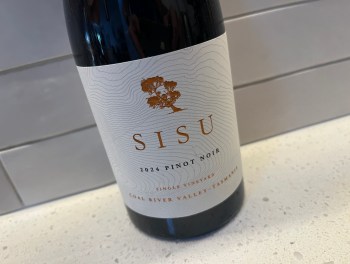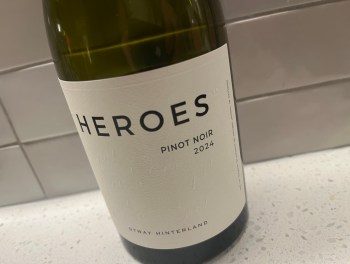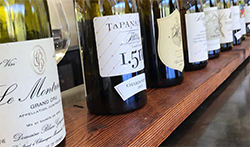 |
| This was once two bottles of Between Five Bells. Hello tissue paper! |
Between Five Bells new releases: Even better
Perhaps it is just a deep-seeded love of presents. Maybe it is just because I’m a tactile person (and fancy soft paper feels excellent). Whatever it is, I really dig tissue wrapped bottles of wine.
Of course not any old bottle of tissue paper makes the grade for there are, like everything, rules for such things. The bottle has to be well wrapped for one, and the paper has to be thin – but not ‘oh fuck I ripped it’ thin. Nor must said paper be overly translucent (or waxy and stiff). Oh and a good print on the paper doesn’t go astray. Maybe a shiny sticker on there too. Or racing stripes…
Naturally, tissue paper alone does not maketh a great wine (and it is annoying to good rid of. A bitch when it gets soggy too) and is only one part of the packaging glory that is these new Between Five Bells (or ‘B5B’ which is the correct acronym. The bottles say so) releases.
On the packaging note, I have to say (again) that I think these are the best wine labels in Australia. The infographics, the colours, the script, all of it – that detail is what makes these special. That white wax on the red too is super sexy (it’s specially imported actually. Looks quite similar to the wax on the Patrick Piuze Chablis range).
Anyway, enough waffling about labels and such (which I quite like talking about). I’ve put a few more images of the bottles and labels (including the Rosé) up on the facebook site now.
Now then, as for these two new wines – well, they’re as intriguing as you’d expect. More to the point, they have a certain congruency that makes them even more impressive than the initial releases before them (2010 Red and 2011 Rosé respectively). What’s more, the 2012 wines to follow – from a far superior vintage – should be better again.
As ever these wines were made in a non-interventionist style (like everything is these days apparently) which means no additions, minimal fining/filtration and low sulphur regimes. They’re also a melange of varieties with whole bunches, natural ferments and extended skin/solids contact.
2011 Between Five Bells White (Geelong, Vic)
12.8%, Screwcap, $29.50 (from the website)
I’m going to quote the PR blurb (which sounds very much like David Fesq’s words) directly for this wines inspiration: ‘The goal for this inaugural white was to share the delicious and intriguing qualities of the Red. To do this, we had committed to co-fermenting a number of varieties’.
 |
| Classy packaging. Red particularly so. |
A blend of almost equal qualities of Riesling, Chardonnay, Pinot Gris and Pinot Meunier all harvested and whole bunch pressed into 1000L cuves for primary fermentation. Extended solids contact and 100% malolactic fermentation to boot. TA 6.48. pH 3.38. 2700 bottles produced.
Much more information on the label!
Super aromatic style this, very much in an Alsace mould, though with a Chablis-esque minerality. All white peach and white flowers aromatics but with mandarin and and a hint of biscuity
richness. The stamp of the super cool season is all over it too, but the weight of the winemaking just fills it out. There is much happening on the nose actually, with every whiff providing a new hint – Chardonnay white fruit, Riesling lime juice and the pear of Pinot Gris. Wonderful.
The palate too is a textural wonder. Vanilla bean oak, peachy Chardonnay juiciness, that malo richness softening what would have been rampant acidity. Light but rich, the length here is excellent too. Perhaps the only quibble is that the acidity is a little hard, the winemaking influences not softening things quite enough (a product of the season no doubt).
An Australian version of an Alsace field blend yet cooler and leaner, this is perhaps a little less polarising than previous B5B wines, but is also – in my opinion – the best B5B wine yet. I’d buy it.
Drink: 2012 – 2014+
Score: 18.1/93
Between Five Bells Red 2011 (Geelong, Vic)
13%, Cork, $31.50 (from website)
Again I’m going to quote away: ‘The major influence on the flavour profile was the vintage conditions’ and it’s writ large too. Sangiovese and Zinfandel didn’t get ripe in 2011, leaving this blend as mainly Shiraz with lesser amounts of Mourvedre and Grenache, topped off with 5% 2011 White.
40% whole bunch ferment for the Shiraz and differing amounts of whole berry ferments for the different varieties (for more info – lots more – check out the label). Matured in 2nd and 3rd use puncheons, this was bottled unfined and unfiltered. TA 7.2 pH 3.53. 3600 bottles produced.
It’s going to be a polarising wine this one. Or it was amongst the non-wine geek (but still informed) drinkers I shared this with. In many ways it’s quite Pinot like actually, starting with the bright, light red colour. It smells Pinotesque too – stemmy, and stalky and really rather backward, with tomato leaf and cranberry fruit.
There is a certain sort of ripe red fruit on the nose but also hints of rot too.
The palate too is anything but fruity. It’s smoky, and spicy and tangy, a bony and fragrant sort of wine with much acidity and a strong line of drying, tea leaf tannins. The challenge with this palate is just how pointed and firm it is – it’s just crying out for more fruit sweetness really. Still, much to like about the form and line.
Drink: 2014 – 2018+
Score: 17.2/90+
Help keep this site paywall free – donate here





4 Comments
I have a mixed case of this, but won't open one for a few months, gives them a chance to become acquainted with their new surroundings.
Thanks for reviewing though.
I think the red can have a couple of years rest but I wonder how the lack of fruit will manifest in say five years time?
The red should no doubt improve and it's a stylish beast, I'd still be drinking it earlier as it may well end up as too structured for the fruit.
Lacking fruit=most French wines, no?
Had a taste of the white a couple of months ago and agree it was excellent + had the extra "interest" factor. Awesome winemaking that delivers. Don't get the Rose – not at all to my taste.